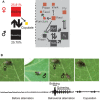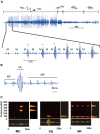Pea leafminer Liriomyza huidobrensis (Diptera: Agromyzidae) uses vibrational duets for efficient sexual communication
- PMID: 29676516
- PMCID: PMC7379950
- DOI: 10.1111/1744-7917.12598
Pea leafminer Liriomyza huidobrensis (Diptera: Agromyzidae) uses vibrational duets for efficient sexual communication
Abstract
The pea leafminer (Liriomyza huidobrensis) is a notorious pest of vegetables and ornamental plants worldwide. Despite a large number of studies on its biology and ecology, the courtship behavior and sexual communication of this species remain unclear. Here, we studied vibrational communication in the sexual interaction of the pea leafminer. On host plant leaves, females and males behaviorally displayed the bobbing-quivering alternation, which finally led to copulation. Moreover, records of laser vibrometry revealed three-signal duets underlying the behavioral alternation. Sexually mature males spontaneously emitted calls (MCs) to initiate the duets. The females rapidly responded to MCs by emitting replies (FRs) that are longer in duration. The FRs further triggered male replies (MRs) in their search for potential partners. Leafminer-produced vibrational signals convey efficient information to partners and generate pair formation on stretched substrates, such as plant leaves and nylon mesh, but cannot elicit responses on dense substrates, such as glass and plastic. Vibrational playbacks of both MCs and FRs can elicit replies in females and males, respectively. This study completely characterizes substrate-borne vibrational duets in a dipteran insect. The discovery of vibrational sex signals in the pea leafminer provides new insights for the development of novel approaches to control the pest and its relative species.
Keywords: Liriomyza; biotremology; courtship behavior; vibrational communication.
© 2018 The Authors. Insect Science published by John Wiley & Sons Australia, Ltd on behalf of Institute of Zoology, Chinese Academy of Sciences.
Figures






Similar articles
-
Female adult puncture-induced plant volatiles promote mating success of the pea leafminer via enhancing vibrational signals.Philos Trans R Soc Lond B Biol Sci. 2019 Mar 4;374(1767):20180318. doi: 10.1098/rstb.2018.0318. Philos Trans R Soc Lond B Biol Sci. 2019. PMID: 30967018 Free PMC article.
-
Substrate-borne vibrational signals and stridulatory organs for sexual communication in leafminer, Liriomyza sativae (Diptera: Agromyzidae).Insect Sci. 2023 Feb;30(1):221-231. doi: 10.1111/1744-7917.13052. Epub 2022 Jun 22. Insect Sci. 2023. PMID: 35557030
-
Molecular Survey for the Invasive Leafminer Pest Liriomyza huidobrensis (Diptera: Agromyzidae) in California Uncovers Only the Native Pest Liriomyza langei.J Econ Entomol. 2014 Oct 1;107(5):1959-64. doi: 10.1603/EC13279. J Econ Entomol. 2014. PMID: 26309286
-
Biotremology: Vibrational communication of Psylloidea.Arthropod Struct Dev. 2022 Jan;66:101138. doi: 10.1016/j.asd.2021.101138. Epub 2022 Jan 21. Arthropod Struct Dev. 2022. PMID: 35074654 Review.
-
Functional Diversity of Vibrational Signaling Systems in Insects.Annu Rev Entomol. 2023 Jan 23;68:191-210. doi: 10.1146/annurev-ento-120220-095459. Epub 2022 Oct 5. Annu Rev Entomol. 2023. PMID: 36198397 Review.
Cited by
-
Acoustic characteristics of sound produced by males of Bactrocera oleae change in the presence of conspecifics.Sci Rep. 2022 Jul 29;12(1):13086. doi: 10.1038/s41598-022-16888-8. Sci Rep. 2022. PMID: 35906260 Free PMC article.
-
Female adult puncture-induced plant volatiles promote mating success of the pea leafminer via enhancing vibrational signals.Philos Trans R Soc Lond B Biol Sci. 2019 Mar 4;374(1767):20180318. doi: 10.1098/rstb.2018.0318. Philos Trans R Soc Lond B Biol Sci. 2019. PMID: 30967018 Free PMC article.
References
-
- Bailey, W.J. (2003) Insect duets: underlying mechanisms and their evolution. Physiological Entomology, 28, 157–174.
-
- Batemen, P.W. (2001) Changes in phonotactic behavior of a bushcricket with mating history. Journal of Insect Behavior, 14, 333–341.
-
- Boumans, L. and Johnsen, A. (2015) Stonefly duets: vibrational sexual mimicry can explain complex patterns. Journal of Ethology, 33(2), 87–107.
-
- Broughton, W.B. (1963) Method in bio‐acoustic terminology Acoustic Behaviour of Animals (ed. Busnel R.G. ), pp. 3–24. Elsevier, Amsterdam.
MeSH terms
Grants and funding
LinkOut - more resources
Full Text Sources
Other Literature Sources

